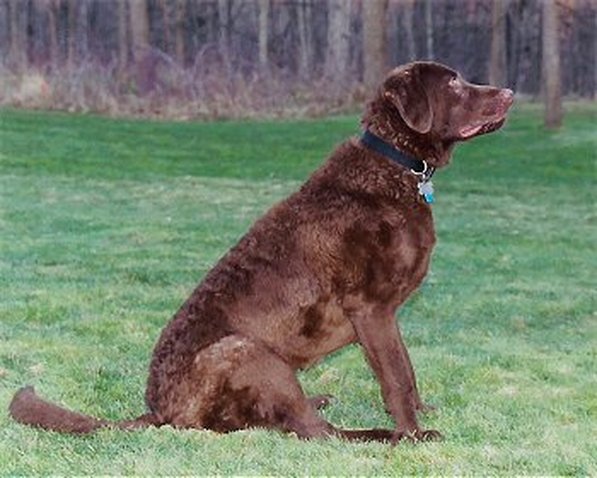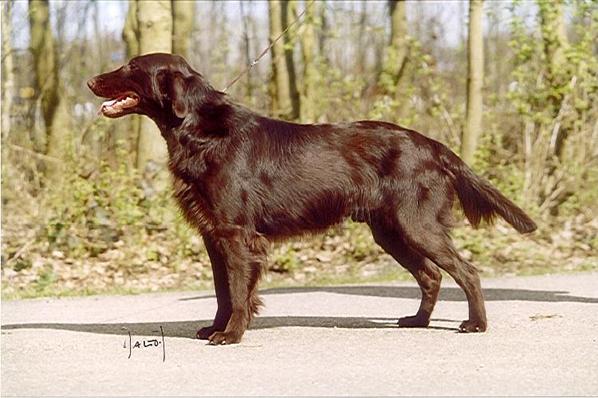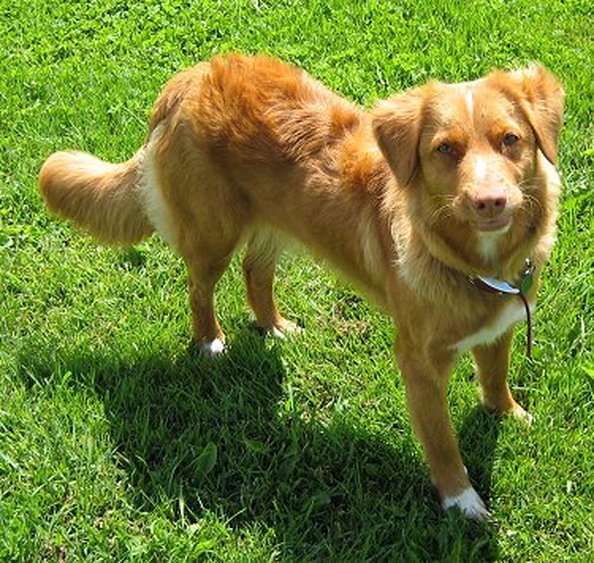CBR, FCR, and NSDTR

Beginning with CBR, and few articles I managed to read, this is what struck me most.
Source: http://www.cbrrescue.org/articles/dontbuy.htm#9
DON'T GET A CHESAPEAKE BAY RETRIEVER IF YOU...
CHESAPEAKE BAY RETRIEVERS ARE NOT THE PERFECT BREED FOR EVERYONE.
As a breed they have a few features that some people find charming, but that some people find mildly unpleasant and some people find downright intolerable.
There are different breeds for different needs. There are over 200 purebred breeds of dogs in the world. Maybe you'd be better off with some other breed. Maybe you'd be better off with a cat. Maybe you'd be better off with goldfish, a parakeet, a hamster, or some house plants.
DON'T GET A CHESAPEAKE BAY RETRIEVER if you are attracted to the breed chiefly by its appearance. From a distance, the appearance of the CBRs you have seen may indicate that they are a chocolate, wavy-haired version of a Labrador Retriever. They are the largest of the retriever breeds and are not from the same lineage as a Labrador - the breedings are entirely different.
Chesapeake Bay retrievers are not related to Goldens or Labradors - and because of this very basic genetic difference, you cannot compare Chessies to these breeds. Chesapeake Bay Retrievers are the result of crosses with Newfoundlands, hounds, setters, water spaniels and other dogs and were first recognized as a distinct breed in America in the middle of the 19th century. They were ducking dogs used by market hunters for retrieving waterfowl and protecting the day’s catch. These early objectives in breeding and selecting for outstanding ducking dogs has endured in today’s Chessies - they are still remarkably tough working dogs and loyal, protective companions. Chessies are not "happy-go lucky" retrievers - they will not "love" everyone they meet. They are indifferent to other people and dogs - very different from Goldens and Labradors. Chesapeakes are unique, intensely loyal, protective, sensitive, and serious dogs - traits that require thoughtful consideration before adopting a dog.
DON'T GET A CHESAPEAKE BAY RETRIEVER if you don't intend to educate (train) your dog. Basic obedience and household rules training is not optional for the Chesapeake Bay Retriever. As an absolute minimum, you must teach him to reliably respond to commands to come, to lie down, to stay, and to walk at your side, on or off leash and regardless of temptations. You must also teach him to respect your household rules: e.g., is he allowed to get on the furniture? Is he allowed to beg at the table? What you allow or forbid is unimportant; but it is critical that you, not the dog, make these choices and that you enforce your rules consistently. You must commit yourself to attending an 8 to 10 week series of weekly lessons at a local obedience club or professional trainer and to doing one or two short (5 to 20 minutes) homework sessions per day. As commands are learned, they must be integrated into your daily life by being used whenever appropriate and enforced consistently.
DON'T BUY A CHESAPEAKE BAY RETRIEVER if you lack leadership (self-assertive) personality. Dogs do not believe in social equality. They live in a social hierarchy led by a pack-leader (Alpha). The alpha dog is generally benevolent, affectionate, and non-bullying towards his subordinates; but there is never any doubt in his mind or in theirs that the alpha is the boss and makes the rules. Whatever the breed, if you do not assume the leadership, the dog will do so sooner or later, and with more or less unpleasant consequences for the abdicating owner. Like the untrained dog, the pack leader dog makes his own rules and enforces them against other members of the household by means of a dominant physical posture and a hard-eyed stare, followed by a snarl, then a knockdown blow or a bite. Breeds differ in tendencies towards social dominance; and individuals within a breed differ considerably.
Chesapeakes as a breed tend to be of a socially dominant personality. You really cannot afford to let a Chesapeake become your boss. You do not have to have the personality or mannerisms of a Marine boot camp Sergeant, but you do have to have the calm, quiet self-assurance and self assertion of the successful parent ("Because I'm your mother, that's why.") or successful grade-school teacher. If you think you might have difficulty asserting yourself calmly and confidently to exercise leadership, then choose a breed known for its socially subordinate disposition, such as a Golden Retriever or a Shetland Sheepdog, and be sure to ask the breeder to select one of the more submissive pups in the litter for you. If the whole idea of "being the boss" frightens or repels you, don't get a dog at all. Leadership and training are inextricably intertwined: leadership personality enables you to train your dog, and being trained by you reinforces your dog's perception of you as the alpha.
DON'T GET A CHESAPEAKE BAY RETRIEVER if you don't value laid-back companionship and calm affection. A Chessie becomes deeply attached and devoted to his own family, but he doesn't "wear his heart on his sleeve." Some are noticeably reserved, others are more outgoing, but few adults are usually exuberantly demonstrative of their affection. They make remarkable eye contact with their favorite people. They like to be near you, usually in the same room, preferably on a comfortable pad or cushion in a corner or under a table, just "keeping you company." They enjoy conversation, petting and cuddling when you offer it, but they are moderate and not overbearing in coming to you to demand much attention. They are emotionally sensitive to their favorite people: when you are joyful, proud, angry, or grief-stricken, your CBR will immediately perceive it and will believe himself to be the cause. The relationship can be one of great mellowness, depth and subtlety; it is a relation on an adult-to-adult level, although certainly not one devoid of playfulness - Chessies are famous for their vocalization with their people (the "roo-roo-roos" and the snorts). As puppies, of course, they will be more dependent, more playful, and more demonstrative. In summary, Chesapeakes tend to be sober and thoughtful, rather than giddy clowns or synchophants. A number of breeds retain into adulthood a more puppyish and playful disposition, e.g., Australian Shepherds, Malamutes, and others. Quite a few are far more dramatically demonstrative and/or more clingingly dependent, e.g., the Golden Retriever.
DON'T GET A CHESAPEAKE BAY RETRIEVER if you believe that dogs should run "free." Whether you live in town or country, no dog can safely be left to run "free" outside your fenced property and without your direct supervision and control. The price of such "freedom" is inevitably injury or death: from dogfights, from automobiles, from the Pound or from justifiably irate neighbors. Even though Chessies are home-loving and less inclined to roam than most breeds, an unfenced CBR is destined for disaster. The unfenced city CBR is likely to exercise his inherited retrieving instinct on joggers, bicyclists, and automobiles. A thoroughly obedience-trained Chesapeake Bay Retriever can enjoy the limited and supervised freedom of off-leash walks with you in appropriately chosen environments. If you don't want the responsibility of confining and supervising your pet, then no breed of dog is suitable for you. A neutered cat will survive such irresponsibly given "freedom" somewhat longer than a dog, but will eventually come to grief. A better answer for those who crave a "free" pet is to set out feeding stations for some of the indigenous wildlife, such as raccoons, which will visit for handouts and which may eventually tolerate your close observation.
Source: http://www.cbrrescue.org/articles/dontbuy.htm#9
DON'T GET A CHESAPEAKE BAY RETRIEVER IF YOU...
- are attracted to the breed chiefly by its appearance
- don't intend to educate (train) your dog
- lack leadership (self-assertive) personality
- want a totally unaggressive and unprotective dog
- are unwilling to share your house and your life with your dog
- don't value laid-back companionship and calm affection
- are fastidious about the neatness of your home
- dislike daily physical exercise
- believe that dogs should run "free"
- can't afford to buy, feed, and provide health care for one
- want the "latest, greatest ferocious killer attack dog"
- are not willing to commit yourself for the dog's entire lifetime
- conclusion
CHESAPEAKE BAY RETRIEVERS ARE NOT THE PERFECT BREED FOR EVERYONE.
As a breed they have a few features that some people find charming, but that some people find mildly unpleasant and some people find downright intolerable.
There are different breeds for different needs. There are over 200 purebred breeds of dogs in the world. Maybe you'd be better off with some other breed. Maybe you'd be better off with a cat. Maybe you'd be better off with goldfish, a parakeet, a hamster, or some house plants.
DON'T GET A CHESAPEAKE BAY RETRIEVER if you are attracted to the breed chiefly by its appearance. From a distance, the appearance of the CBRs you have seen may indicate that they are a chocolate, wavy-haired version of a Labrador Retriever. They are the largest of the retriever breeds and are not from the same lineage as a Labrador - the breedings are entirely different.
Chesapeake Bay retrievers are not related to Goldens or Labradors - and because of this very basic genetic difference, you cannot compare Chessies to these breeds. Chesapeake Bay Retrievers are the result of crosses with Newfoundlands, hounds, setters, water spaniels and other dogs and were first recognized as a distinct breed in America in the middle of the 19th century. They were ducking dogs used by market hunters for retrieving waterfowl and protecting the day’s catch. These early objectives in breeding and selecting for outstanding ducking dogs has endured in today’s Chessies - they are still remarkably tough working dogs and loyal, protective companions. Chessies are not "happy-go lucky" retrievers - they will not "love" everyone they meet. They are indifferent to other people and dogs - very different from Goldens and Labradors. Chesapeakes are unique, intensely loyal, protective, sensitive, and serious dogs - traits that require thoughtful consideration before adopting a dog.
DON'T GET A CHESAPEAKE BAY RETRIEVER if you don't intend to educate (train) your dog. Basic obedience and household rules training is not optional for the Chesapeake Bay Retriever. As an absolute minimum, you must teach him to reliably respond to commands to come, to lie down, to stay, and to walk at your side, on or off leash and regardless of temptations. You must also teach him to respect your household rules: e.g., is he allowed to get on the furniture? Is he allowed to beg at the table? What you allow or forbid is unimportant; but it is critical that you, not the dog, make these choices and that you enforce your rules consistently. You must commit yourself to attending an 8 to 10 week series of weekly lessons at a local obedience club or professional trainer and to doing one or two short (5 to 20 minutes) homework sessions per day. As commands are learned, they must be integrated into your daily life by being used whenever appropriate and enforced consistently.
DON'T BUY A CHESAPEAKE BAY RETRIEVER if you lack leadership (self-assertive) personality. Dogs do not believe in social equality. They live in a social hierarchy led by a pack-leader (Alpha). The alpha dog is generally benevolent, affectionate, and non-bullying towards his subordinates; but there is never any doubt in his mind or in theirs that the alpha is the boss and makes the rules. Whatever the breed, if you do not assume the leadership, the dog will do so sooner or later, and with more or less unpleasant consequences for the abdicating owner. Like the untrained dog, the pack leader dog makes his own rules and enforces them against other members of the household by means of a dominant physical posture and a hard-eyed stare, followed by a snarl, then a knockdown blow or a bite. Breeds differ in tendencies towards social dominance; and individuals within a breed differ considerably.
Chesapeakes as a breed tend to be of a socially dominant personality. You really cannot afford to let a Chesapeake become your boss. You do not have to have the personality or mannerisms of a Marine boot camp Sergeant, but you do have to have the calm, quiet self-assurance and self assertion of the successful parent ("Because I'm your mother, that's why.") or successful grade-school teacher. If you think you might have difficulty asserting yourself calmly and confidently to exercise leadership, then choose a breed known for its socially subordinate disposition, such as a Golden Retriever or a Shetland Sheepdog, and be sure to ask the breeder to select one of the more submissive pups in the litter for you. If the whole idea of "being the boss" frightens or repels you, don't get a dog at all. Leadership and training are inextricably intertwined: leadership personality enables you to train your dog, and being trained by you reinforces your dog's perception of you as the alpha.
DON'T GET A CHESAPEAKE BAY RETRIEVER if you don't value laid-back companionship and calm affection. A Chessie becomes deeply attached and devoted to his own family, but he doesn't "wear his heart on his sleeve." Some are noticeably reserved, others are more outgoing, but few adults are usually exuberantly demonstrative of their affection. They make remarkable eye contact with their favorite people. They like to be near you, usually in the same room, preferably on a comfortable pad or cushion in a corner or under a table, just "keeping you company." They enjoy conversation, petting and cuddling when you offer it, but they are moderate and not overbearing in coming to you to demand much attention. They are emotionally sensitive to their favorite people: when you are joyful, proud, angry, or grief-stricken, your CBR will immediately perceive it and will believe himself to be the cause. The relationship can be one of great mellowness, depth and subtlety; it is a relation on an adult-to-adult level, although certainly not one devoid of playfulness - Chessies are famous for their vocalization with their people (the "roo-roo-roos" and the snorts). As puppies, of course, they will be more dependent, more playful, and more demonstrative. In summary, Chesapeakes tend to be sober and thoughtful, rather than giddy clowns or synchophants. A number of breeds retain into adulthood a more puppyish and playful disposition, e.g., Australian Shepherds, Malamutes, and others. Quite a few are far more dramatically demonstrative and/or more clingingly dependent, e.g., the Golden Retriever.
DON'T GET A CHESAPEAKE BAY RETRIEVER if you believe that dogs should run "free." Whether you live in town or country, no dog can safely be left to run "free" outside your fenced property and without your direct supervision and control. The price of such "freedom" is inevitably injury or death: from dogfights, from automobiles, from the Pound or from justifiably irate neighbors. Even though Chessies are home-loving and less inclined to roam than most breeds, an unfenced CBR is destined for disaster. The unfenced city CBR is likely to exercise his inherited retrieving instinct on joggers, bicyclists, and automobiles. A thoroughly obedience-trained Chesapeake Bay Retriever can enjoy the limited and supervised freedom of off-leash walks with you in appropriately chosen environments. If you don't want the responsibility of confining and supervising your pet, then no breed of dog is suitable for you. A neutered cat will survive such irresponsibly given "freedom" somewhat longer than a dog, but will eventually come to grief. A better answer for those who crave a "free" pet is to set out feeding stations for some of the indigenous wildlife, such as raccoons, which will visit for handouts and which may eventually tolerate your close observation.
The 2nd and closest “relatives” I concur is that of the Flat coated Retrievers

Source: http://www.fcrsainc.org/breedstandard/index.html
The Flat-Coated Retriever was once considered a generic "Labrador" type dog, called a "Retriever Proper". It was developed in the 1800s from various retriever and spaniel water type dogs such as the Newfoundland, Irish Setter, Labrador, Water Spaniels and possibly the Collie. Some of these dogs were born with a flat, wavy coat and eventually they were categorized as a separate breed becoming the Flat-Coated Retriever.Flat-coated Retrievers are the lightest of the Retrievers and are members of the Gundog group. They are both working dogs when they retrieve shot birds, hares and rabbits, and companions. The Peter Pan of retrievers is known for its sense of humor.At first glance, you might think the Flat-Coated Retriever resembles a black or brown Golden Retriever, but no such thing. They generally mature more slowly than other dogs and maintain their puppylike exuberance for years. This playful energy makes them a wonderful and entertaining companion, but it also means extra time and patience when training them. While they are eager to please, Flat-Coats are hams, and they won't hesitate to go for a laugh, even if it means ignoring or disobeying you. Skull and Muzzle-The impression of the skull and muzzle being "cast in one piece". Stop-There is a gradual, slight, barely perceptible stop, avoiding a down or dish-faced appearance.
Lastly, but I doubt it, are the Canadian “trollers” (NSDTR)

Source: http://en.wikipedia.org/wiki/Nova_Scotia_Duck_Tolling_Retriever
http://www.dogbreedinfo.com/novascotiaducktolling.htm
The Nova Scotia Duck-Tolling Retriever looks somewhat like a small Golden Retriever. The coat is dense, and comes in various shades of red and orange. It usually has small white markings on the feet, chest, tail tip and sometimes face.
The Toller was officially admitted to the Canadian Kennel Club in 1945.[3] 56 years later, on June 11, 2001, it was approved for admission into the Miscellaneous Class of the American Kennel Club and was granted full recognition into the Sporting Group on July 1, 2003.
